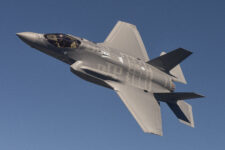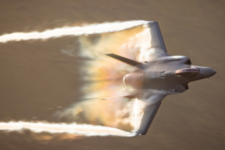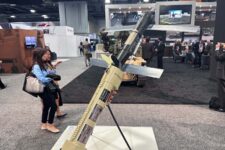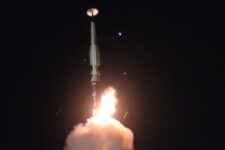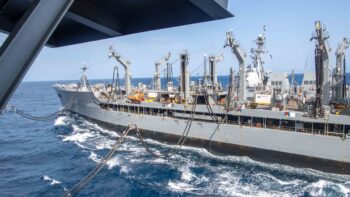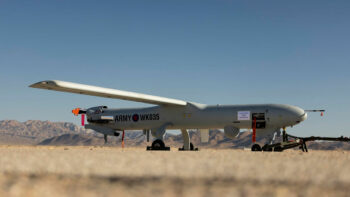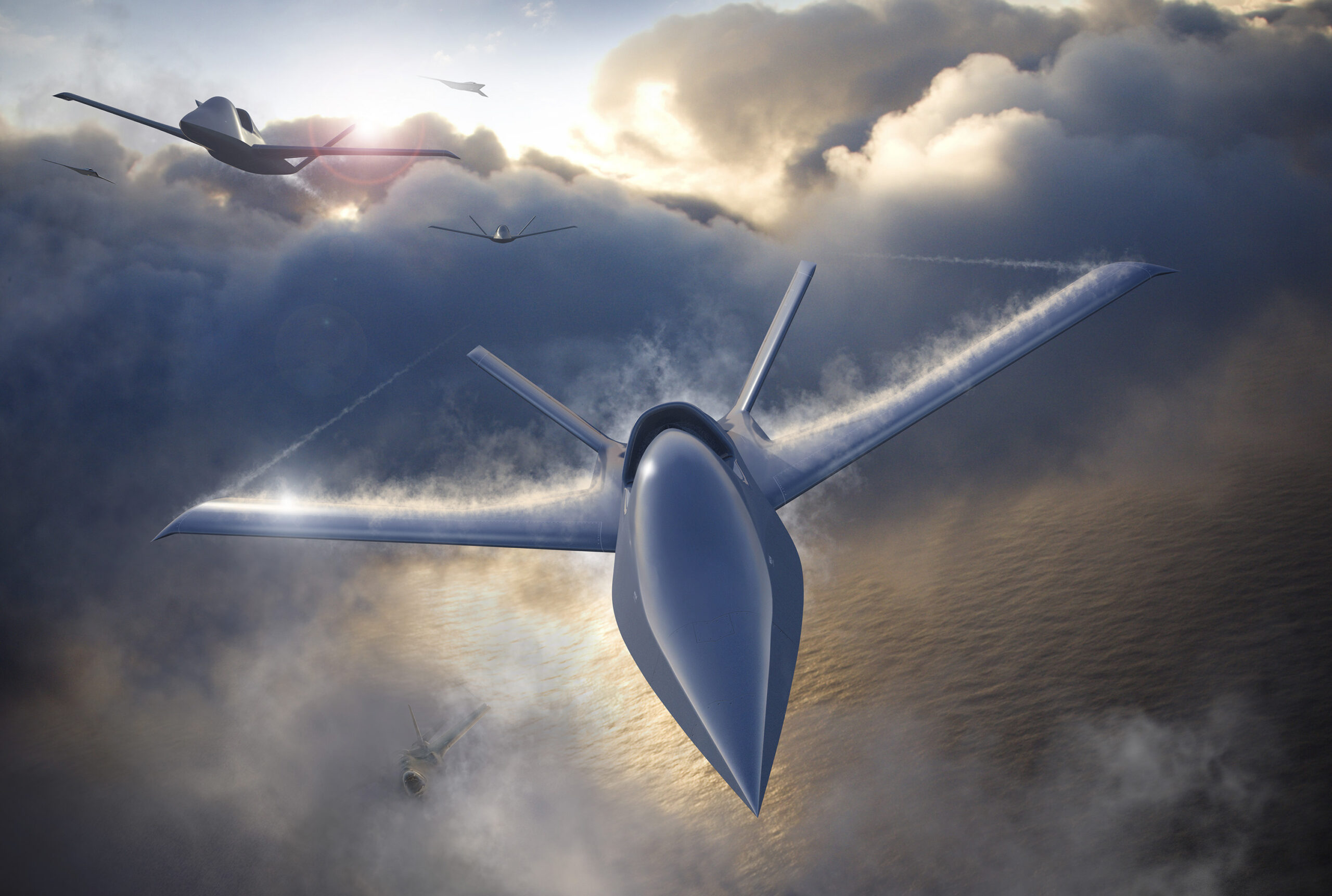
NATO and partner nations flying the F-35 can leverage its digital infrastructure to host and control Autonomous Collaborative Platforms such as Northrop Grumman’s M437 from Scaled Composites. (Northrop Grumman illustration)
The war of attrition and stalemate in Ukraine’s battle for its homeland is arguably the greatest rationale for the UK, US, and NATO nations to invest in overmatch technologies that create strategic advantage against near peers. These capabilities should extend from seabed to space and their execution will depend on novel solutions from all involved.

Nick Chaffey is Northrop Grumman’s chief executive and general manager for UK.
“Bear in mind that about 1,000 miles away, we have a genuine war ongoing on the ground in Europe,” noted Nick Chaffey, Northrop Grumman’s chief executive and general manager for UK, speaking from their Cheltenham HQ in Gloucestershire, England. “We feel that quite directly, and some of our close NATO allies like Poland feel it extraordinarily directly as there’s a war on their doorstep. Not forgetting what’s going on in the Middle East and the threats in the far east from China, but the real focus of Europe and the UK is the threats in Europe.”
In the air domain, the priority for the Royal Air Force and European air forces is its focus on NATO. That means defending the airspace and improving ISR across Europe, and increasingly being able to operate in denied airspace by building on the lessons from Ukraine.
The acquisition of F-35 across Europe as a next-generation platform is meeting those objectives, while also stimulating Europe to build its own sixth-generation fighter programs such as Future Combat Air System (FCAS) and Global Combat Air Programme (GCAP) that will sustain and grow their industrial capabilities.
“In the event of something else happening in Europe, we need air-based supremacy to make sure we don’t end up in a traditional ground-based war like we’re seeing in Ukraine,” said Chaffey. “That is at the forefront of the minds of many defence secretaries across Europe and the UK, which is driving their priorities.”
Aircraft survivability is vital to maintaining air-based supremacy. With aircraft such as the F-16 planned to serve in NATO air forces for many years, Northrop Grumman’s advanced systems — including the AN/APG-83 Scalable Agile Beam Radar and Integrated Viper Electronic Warfare Suite — are essential elements in enabling the freedom of maneuver in contested airspace.
A centerpiece for missile defence
The capacity of warfighters to integrate data across warfighting and security domains, including cyber, is increasingly critical to fielding an effective force in complex battlespace. The goal is not to just collaborate with allies but to genuinely interoperate.
In addition to building the center fuselage and the AN/APG-81 active electronically scanned array (AESA) for the F-35, Northrop Grumman is doing just that by expanding NATO and European defensive capabilities in numerous ways – including all-important missile defence through the Integrated Battle Command System (IBCS).
In Poland, the company worked with the Polish Ministry of National Defence and local industry on initial operating capability for IBCS, which is the centerpiece of its modernization strategy for both their WISLA medium-range air and their NAREW short-range air and missile modernization defence programs. Northrop Grumman continues to partner with local industry to deliver the second phase of the program, which includes tailored implementation. Poland is the first international partner to acquire this transformational capability.
“The ability for IBCS to integrate data from multiple domains and multiple sensors into a single integrated tactical and strategic picture to allow best-effect operations is increasingly important,” said Chaffey. “We’re all seeing the criticality of being able to use the best effector in the Red Sea where cheap drones are being countered with expensive weaponry. That’s not affordable at any strategic battle level because we’ll simply run out of important munitions too quickly and economically risk losing the war in that situation.”
A primary advantage of IBCS is its ability to better match the most economic, available, and appropriate weapon to the incoming threat. One of the lessons from both Ukraine and the Middle East is that munition stockpiles and magazines can be managed more effectively to sustain the fight and be more effective as the fight goes up.
“With IBCS, our customers are saying that, yes, it’s important to do the multi-country integration and provide an integrated picture of what’s going on, but also then to have the ability to choose the optimal effector and to do so in a way that sustains your magazine becomes even more important,” said Chaffey.

In the air domain, achieving “overmatch” means having better ISR across Europe and heeding electronic-warfare lessons learned from Ukraine. (Northrop Grumman graphic)
Supporting the UK’s priority programmes
Northrop Grumman is supporting the UK’s most vital programmes, and is investing to build what the UK market would call a sovereign business in the UK, i.e., a business based on a UK team working on UK facilities and available to the UK government. With a 1,000-person staff, Northrop Grumman UK is focused in several primary areas.
The first is the maritime sector, where the company does platform management and command and control for the Royal Navy’s fleet. It is the provider of the Recognized Maritime Picture for NATO, which is a database of ships and nationalities, their movements, and anything suspicious that warrants further investigation.
Another is cybersecurity, where Northrop Grumman has built a preeminent position supporting the UK government on defensive cyber capabilities. And, as discussed, many of Northrop Grumman’s capabilities also underpin the Royal Air Force’s ability to operate F-35s at an advanced level.
“We’re talking to the Royal Air Force about how it evolves its needs as we understand what the next generation of air domain battles are going to look like,” said Chaffey. “That includes the UK’s acquisition of the E-7 Wedgetail, which includes Northrop Grumman’s Multi-Role Electronically Scanned Array (MESA) multifunction surveillance radar and infrared countermeasures. Several of those systems are now being integrated onto the aircraft in Birmingham.”
As part of the air domain battle, the company is also working on the challenge of integrating multiple tactical pictures into a strategic view of the battlefield. It’s a goal for both The British Army, which is developing a Ground Based Air Defence (GBAD) programme, and the Royal Air Force, which is working on integrated air and missile defence (IAMD).
Northrop Grumman is partnered with both groups to examine how the IBCS system can play into those requirements and transform the IAMD and GBAD requirements for the UK by delivering both a functional capability in the short-term and a platform for long-term C2 in the complex environments.
The time is today
The F-35 will soon be the predominant fighter in the western world. With the air battle in Europe evolving, the challenge becomes how partner nations flying the Lightning II can leverage its digital infrastructure to enhance capabilities such as hosting and controlling Autonomous Collaborative Platforms (ACPs), for example. There’s also a stated desire from governments across Europe to collaborate on the development and deployment of ACPs.
One of the main lessons learned from Ukraine, and from overt Russian threats against NATO nations arming Ukraine, is that unique non-interoperable systems only hinder NATO’s collective ability to defend the alliance and partners. Where would Ukraine be if countries like the U.S. and Australia, as well as numerous European Union nations, didn’t have vast quantities of compatible 155mm artillery shells to share? As networked platforms like F-35 populate fleets across the European continent, the time to develop pan-NATO-and-partner commonality in areas like weaponry, command and control, and networking is today.
At the same time, Northrop Grumman is bringing new platforms online such as the B-21 Raider, which is built upon an advanced digital architecture that will allow it to be interoperable with F-35 and potentially other platforms developed under programs like Europe’s Future Combat Air System (FCAS) and the Global Combat Air Programme.
“That approach is not yet being fully leveraged in the European domain,” observed Chaffey. “To that end, though, we are working to help Europe accelerate its aircraft development, move to open digital architectures, plug in ACPs and collaborate on the development of them to make sure we have air forces in Europe that can meet the threat in the 2030s and beyond.
“We’re hearing from our customers in the UK and Europe that they do want the leading-edge technology that the US has, but they also want the ability to develop that technology, make it bespoke, iterate it, sustain it, develop it, and apply it in their own countries alongside domestic capabilities to get the full value from that technology. Not just from a defense perspective, but also from an industrial and economic capability.”
